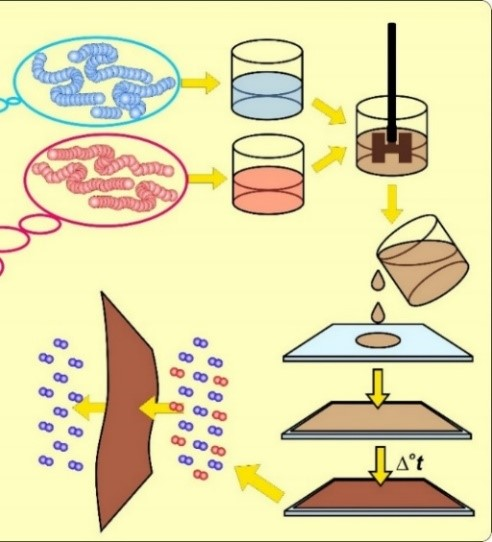Sumary of the main results obtained during project implementation in 2022:
Stage I (year 2022) of memPIM-PIs project aimed at developing a technology for preparation of polymer membranes for CO2 separation/capture based on polyimides containing voluminous DOPO units and mixtures of polyimides based on them. For this purpose, an aromatic diamine-type monomer containing DOPO group grafted on a triazine ring was synthesized. Based on it, three polyimides with DOPO units and different chain flexibilities modulated by the variable structure of the diimide segment were prepared. Polymer synthesis reactions were accomplished by direct polycondensation, in a single step, at high temperature, in a polar aprotic solvent. The polymers with DOPO units were structurally characterized by spectral methods (FTIR, 1H and 31P-NMR), which confirmed their correct structure.
Upon excitation with UV light, the synthesized polyimides with DOPO units exhibited weak fluorescence in the blue-green spectral range, due to the presence of the charge transfer complex developed between the diamine segment as an electron donor and the diimide segment as an electron acceptor. All polymers showed good solubility in polar aprotic solvents such as DMF, NMP, DMAc, which allowed their processing from solution in form of films. Although an extensive work was carried out to optimize the processing conditions of these polymers in form of self-standing membranes, only brittle films were obtained, which cannot be detached from the support. Therefore, the DOPO-containing polyimides were mixed with a polyimide based on 6FDA with very good film-forming properties, whose synthesis was carried out starting from commercial monomers. Thus, 7 polymer blends were prepared in different mass ratios, which were processed in form of membranes with good mechanical integrity.
In order to obtain uniform membranes, the application of a controlled thermal regime to the blend solutions was applied after establishing the optimal processing conditions and the optimal ratios between the two components of the blend. The resulting self-standing membranes were characterized from the morphological and miscibility point of view, the experimental results demonstrating their uniformity and the homogeneous mixing at the molecular level of the two polymeric components. In the next stage of the project, these membranes will be characterized from the physico-chemical point of view and explored with regard to the gas permeation capacity, with an emphasis on the separation/capture of CO2. Part of the outcome results of this project stage were disseminated in the form of 2 oral communications at international scientific events and a review paper was published in the ISI journal "Chemistry".

Membrane preparation process
Sumary of the main results obtained during project implementation in 2023:
Stage 2 (year 2023) of memPIM-PIs project has as main objective to investigate from the physico-chemical point of view all membranes obtained from the polymer blends reported in Stage 1, in which one of the components is a polyimide with a bulky DOPO unit (DOPO-PI), as well as to test them for permeation of different gases, with emphasis on CO2 separation/capture. Another objective of this stage consisted in the development of a technology for membranes preparation suitable for CO2 separation/capture based on polyimides containing triphenylamine substituted with trityl units (TTA) and their mixtures with a fluorinated polyimide. Thus, the blends based on DOPO-PI were analyzed from thermal, mechanical, dielectric, and chemical resistance point of view. They showed high thermal stability, up to 404–509°C, function on the composition of the blend, while the glass transition temperature was between 222 and 250°C.
The membranes had good mechanical integrity and flexibility, with tensile strength in the range of 47–91 MPa. In addition, they did not degrade in acidic or basic corrosive environments, demonstrating a very good chemical resistance, necessary in gas separation processes. Dielectric spectroscopy studies have shown that segmental and chain mobility is allowed in these blended membranes, despite the strong interactions in which the two constitutive components are involved. The membranes were tested in permeation processes of several gases, such as O2, N2, He and CO2, and based on the obtained results, the ability to separate CO2 from gas mixtures was evaluated. Also, the results were highlighted in Robeson diagrams, and solutions to improve their performances were proposed.
A second structural strategy was further approached to obtain membranes based on polymer blends. For this purpose, we resorted to the synthesis of a new monomer containing triphenylamine substituted with trityl units (TTA), which has a central nitrogen atom with affinity towards CO2. After structural identification, this diamine-type monomer was used in polycondensation reactions with different aromatic dianhydrides to obtain 3 polyimides with bulky TTA units. These polymers were characterized from structural and physico-chemical point of view, in order to evaluate the optical, thermal and electrochemical properties. Since these polyimides based on TTA did not give free-standing films with good mechanical integrity, they were subjected to blending in different proportions with a polyimide based on 6FDA, with excellent film-forming ability. Following an extensive optimization process regarding the processing conditions and the ratios between the two components of the blends, 7 membranes with good mechanical integrity were obtained, whose investigation sugested the miscibility at the molecular level of the two components. These membranes will be studied in detailed, and afterwards tested in the separation process of CO2 from gas mixtures in the Stage 3 of the project. Part of the results obtained in Stage 2 of memPIM-PIs project were disseminated in international scientific events in the form of 2 invited conferences, 2 communications (including a short one) and 2 posters. Also, based on the obtained results, 2 ISI papers were published in Molecules and Progress in Organic Coatings journals, as well as 2 chapters in the book Polyimides: Advances in Blends and Nanocomposites, edited by Elsevier.

Membranes obtained
Sumary of the main results obtained during project implementation in 2024:
Stage 3 (year 2024) of the memPIM-PIs project aimed at establishing the physico-chemical characteristics and evaluating the gas permeation performance of the membranes based on blends prepared from polyimides with bulky TTA units and a fluorinated polyimide, which were reported in Stage 2 of the project. The thermal analysis data indicated that all membranes exhibited very high thermal stability, with decomposition starting at temperatures above 510°C. Regardless of the blend composition or the nature of the TTA-based polyimide involved in the blend formation, the thermal stability varied within very small limits, which is a remarkable result. DSC curves highlighted the presence of a single glass transition temperature (Tg) ranging from 283 to 291°C, which is closer to the Tg value of the fluorinated polyimide 6F-PI (Tg = 293°C), suggesting good molecular compatibility of the blend components.
The membranes showed good chemical stability in a basic environment, while a 10% decrease in transmittance was observed in an acidic medium, even after 1 hour of exposure, attributed to the formation of the chloride at the central N atom of TPA and less to a degradation process. The tensile strength was found in the range of 66.94–104.65 MPa, indicating very good mechanical characteristics, specific to rigid polymeric materials. The transmittance spectra highlighted a significant increase in the λcut-off and a decrease in optical transparency as the blend incorporates a larger amount of TTA-PI, which is associated with an intensification of CTC interactions in the studied membranes. The activation energies of β relaxations found for blends were considerably higher than those for 6F-PI, reaching values of up to 104.8 kJ/mol, which indicate intensified interactions between the blend components and reduced segmental mobility compared to the reference polyimide. The separation capacity of CO2 from gas mixtures was evaluated in gas permeation processes of O2, N2, He, and CO2 through the studied membranes, whose permeability coefficients, diffusivities, solubilities, and their corresponding selectivities were determined.
The best results for CO2 separation were obtained for the series of polymers based on 3,4-BiPh, showing a simultaneous increase in permeability and selectivity. On the other hand, the blend with the strongest chain packing (ODA 70:30) exhibited the highest CO2 storage capability. Some of the results obtained in Stage 3 were disseminated in international scientific events in the form of 3 oral presentations and 1 poster, as well as in the form of 2 papers submitted for publication in ISI journals. The results with the highest applicative potential formed the subject of a patent application with OSIM. |








